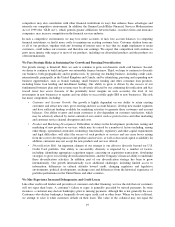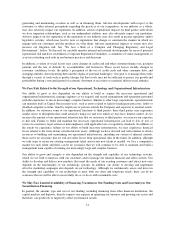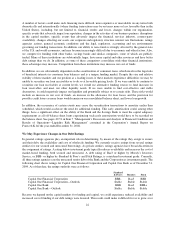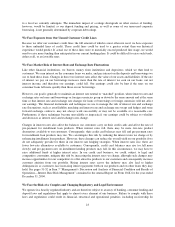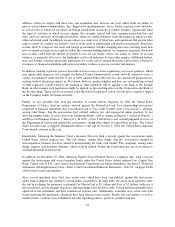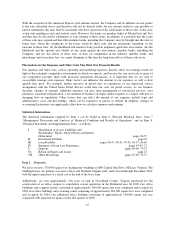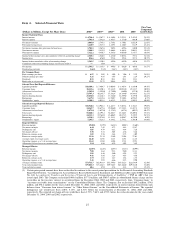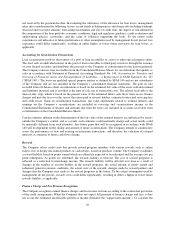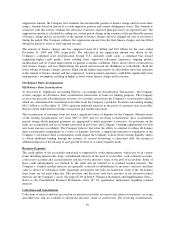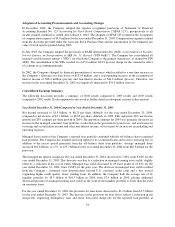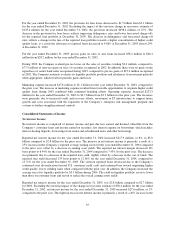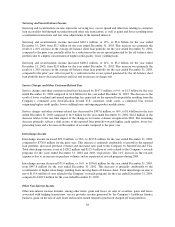Capital One 2004 Annual Report Download - page 52
Download and view the complete annual report
Please find page 52 of the 2004 Capital One annual report below. You can navigate through the pages in the report by either clicking on the pages listed below, or by using the keyword search tool below to find specific information within the annual report.not received by the payment due date. In evaluating the sufficiency of the allowance for loan losses, management
takes into consideration the following factors: recent trends in delinquencies and charge-offs including bankrupt,
deceased and recovered amounts; forecasting uncertainties and size of credit risks; the degree of risk inherent in
the composition of the loan portfolio; economic conditions; legal and regulatory guidance; credit evaluations and
underwriting policies; seasonality; and the value of collateral supporting the loans. To the extent credit
experience is not indicative of future performance or other assumptions used by management do not prevail, loss
experience could differ significantly, resulting in either higher or lower future provision for loan losses, as
applicable.
Accounting for Securitization Transactions
Loan securitization involves the transfer of a pool of loan receivables to a trust or other special purpose entity.
The trust sells an undivided interest in the pool of loan receivables to third-party investors through the issuance
of asset backed securities and distributes the proceeds to the Company as consideration for the loans transferred.
The Company removes loan receivables from the Consolidated Balance Sheets for securitizations that qualify as
sales in accordance with Statement of Financial Accounting Standards No. 140, Accounting for Transfers and
Servicing of Financial Assets and Extinguishment of Liabilities – a Replacement of FASB Statement No. 125
(“SFAS 140”). The trusts are qualified special purpose entities as defined by SFAS 140 and are not subsidiaries
of the Company and are not included in the Company’s consolidated financial statements. The gain on sale
recorded from off-balance sheet securitizations is based on the estimated fair value of the assets sold and retained
and liabilities incurred, and is recorded at the time of sale, net of transaction costs. The related receivable is the
interest-only strip, which is based on the present value of the estimated future cash flows from excess finance
charges and past-due fees over the sum of the return paid to security holders, estimated contractual servicing fees
and credit losses. Gains on securitization transactions, fair value adjustments related to residual interests and
earnings on the Company’s securitizations are included in servicing and securitizations income in the
Consolidated Statements of Income and amounts due from the trusts are included in accounts receivable from
securitizations on the Consolidated Balance Sheets.
Certain estimates inherent in the determination of the fair value of the retained interests are influenced by factors
outside the Company’s control, and as a result, such estimates could materially change and actual results could
be materially different from such estimates. Any future gains that will be recognized in accordance with SFAS
140 will be dependent on the timing and amount of future securitizations. The Company intends to continuously
assess the performance of new and existing securitization transactions, and therefore the valuation of retained
interests, as estimates of future cash flows change.
Rewards
The Company offers credit cards that provide reward program members with various rewards such as airline
tickets, free or deeply discounted products or cash rebates, based on purchase volume. The Company establishes
a reward liability based on points earned which are ultimately expected to be redeemed and the average cost per
point redemption. As points are redeemed, the rewards liability is relieved. The cost of reward programs is
reflected as a reduction to interchange income. The rewards liability will be affected over time as a result of
changes in the number of account holders in the reward programs, the actual amount of points earned and
redeemed, general economic conditions, the actual costs of the rewards, changes made by reward partners and
changes that the Company may make to the reward programs in the future. To the extent assumptions used by
management do not prevail, rewards costs could differ significantly, resulting in either a higher or lower future
rewards liability, as applicable.
Finance Charge and Fee Revenue Recognition
The Company recognizes earned finance charges and fee income on loans according to the contractual provisions
of the credit arrangements. When the Company does not expect full payment of finance charges and fees, it does
not accrue the estimated uncollectible portion as income (hereafter the “suppression amount”). To calculate the
29


